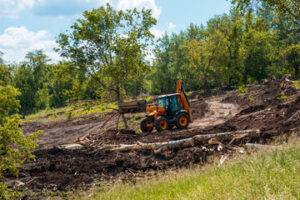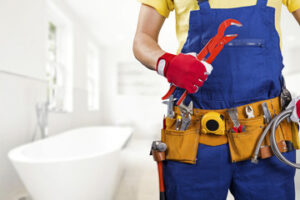Land Clearing involves removing trees, brush, and other vegetation for various reasons. Proper planning and consideration can help ensure that the clearing process runs smoothly and avoids delays.

Permit requirements, proper grading, and implementing erosion control strategies are all part of the process. These measures prevent costly delays during the construction phase.
The first step in land clearing is to obtain a permit or clearance from the local authority. This will allow you to clear the land in accordance with local environmental and zoning regulations. A permit will also ensure that the process is completed in a way that does not damage or harm the surrounding ecosystem. A professional tree service will be able to get these permits for you.
After obtaining a permit or clearance, the next step is to conduct a site inspection. This will help you to determine the type of vegetation that needs to be removed and the best methods to use for clearing it. The inspection will also allow you to identify any potential hazards that may need to be addressed before starting work. The next step is to develop a clearing plan that outlines the methods and equipment to be used for clearing the vegetation. The plan will also include a schedule for the completion of each task.
When the site survey and clearing plan have been completed, the actual work begins. This can be done using a variety of tools and machinery, including chainsaws, backhoes, and bulldozers. For small areas, hand tools can be used to cut down trees and underbrush. For larger areas, heavier machinery is needed to clear large trees and thick vegetation. In some cases, herbicides may be used to kill unwanted vegetation before it is removed manually or mechanically.
Once the vegetation has been cleared, it is removed from the site and hauled away for disposal. In some cases, it may be chipped or ground up to be used for landscaping purposes, or it can be mulched. Debris that cannot be reused or recycled is then hauled off to a landfill for disposal.
The land clearing process can be beneficial for a number of reasons. It can prepare a property for construction, improve its aesthetics, and increase its value. In addition, it can help prevent wildfires by reducing the amount of combustible vegetation on a property. It can also improve the safety and accessibility of a property by removing brush and weeds that can create trip or fall hazards.
Grading
Land grading is an important step in preparing for construction, farming or gardening. It reduces erosion and helps water flow into drainage systems, instead of pooling in undesirable areas. It also ensures a smooth foundation for building, preventing structural damage over time.
When done correctly, the grading process transforms the site’s existing contours to match desired slopes and contours. Once the site has been cleared, a grading contractor can use heavy equipment like bulldozers or excavators to cut and fill soil, reshape the land, and achieve required slopes. Often, this is followed by soil remediation and other site work services that prepare the land for future construction.
The process of grading land requires a great deal of care and expertise. Experienced contractors will be able to assess the terrain, soil composition and local regulations and provide recommendations specific to your property. During this process, it is important to locate and mark any underground utility lines that may be in the area. Failure to do so could result in costly damages and legal liabilities for the property owner.
One of the most important aspects of land grading is the ability to understand and work with the natural drainage patterns on your property. Altering these patterns without this knowledge can cause flooding, soil degradation, and other problems. Professional grading contractors will be able to ensure that your drainage system works in harmony with the landscape, directing water away from sensitive areas.
A good way to tell if your land needs grading is by noticing standing water after a rainstorm. This can be a sign that the ground isn’t draining properly, or that the soil is too compacted. You can also observe if your yard is uneven, with puddles or patches of grass that aren’t growing as well as the rest of the yard.
In addition to reducing erosion and improving drainage, proper grading can reduce the need for irrigation and improve the quality of your soil. Soil that is too compacted will not be able to hold moisture and nutrients as effectively, leading to lower crop yields. Improving your soil quality with grading can also help with pest management and increase the longevity of your landscaping.
Inspection
Land clearing involves removing trees, bushes, and debris from an area to prepare it for construction or agricultural use. It is an important step in developing property, but it must be done properly to ensure compliance with local and state regulations. Land clearing can also help improve safety and property value by removing unsafe or unattractive features. Professional land clearing services offer a wide variety of options, including tree cutting, stump removal, and brush clearance. They can also assist with obtaining the necessary permits and approvals required for the project.
To begin the process, a professional land clearing company assesses the site to determine which methods are best for clearing. They may use a variety of tools and equipment to remove vegetation, including chainsaws, excavators, bulldozers, and brush mowers. After clearing the vegetation, they use other methods to stabilize and prepare the land for its intended development. This can include adding soil amendments and using bulldozers to level the land. Erosion control measures such as silt fences and seeding and mulching are often used to promote vegetation growth and prevent erosion.
During the land clearing process, professionals make safety their top priority. They follow established safety protocols and ensure all employees understand the risks involved in each activity. Additionally, they ensure that all equipment is in good working condition and are trained in its operation. This helps to reduce injuries and downtime, ensuring that the project is completed quickly and efficiently.
Before a land clearing project begins, it is important to clearly mark the boundaries of the worksite. This helps to ensure that only the areas required for clearing are worked on and protects any valuable or unique features of the property. In addition, it helps to ensure that the right types of vegetation are cleared and that any hazardous materials are removed.
Once the land clearing process is complete, a thorough inspection is conducted to identify any remaining debris or obstructions. This can help to prevent costly mistakes in the future and minimize the impact on the environment. By diligently evaluating and addressing maintenance considerations, the clear-cutting method can be used effectively throughout the clearing process and beyond.
Hand Clearing
When clearing land, there are many different ways to go about it. Some are more environmentally-friendly than others, while others are faster or easier. However, the best way to clear land depends on the final purpose for which it will be used. For example, clearing land for a pasture or lawn may be much easier than clearing it for construction.
The most common method of clearing land involves using machinery. Generally, large machines like bulldozers are used to clear major obstructions from the site, while hand-held tools such as axes and machetes can be used for smaller weeds and brush. This approach is ideal for delicate ecosystems or precise work near existing structures, as it minimizes soil disturbance. It is also more selective and allows for more precise removal of certain plants.
Other methods of clearing land include burning, herbicides, and mulching. Burning is a fast and effective method, but it can also be dangerous, especially in areas with high fire risks. Herbicides are effective in killing existing vegetation, but can have negative effects on the surrounding environment. Mulching, on the other hand, can help improve soil health and is a great alternative to traditional chemical-based methods.
Another popular method of clearing land is to use animals. This can be a great choice for people who want to keep their land as close to its natural state as possible, or who have the time and resources to care for animals. However, clearing land with animals is typically a slower process than other options. Animals must be fenced in, fed and watered regularly, and provided with proper vet care.
In addition, clearing land with animals can be costly if it is not done properly. This is particularly true if the animals are not properly trained or managed. For this reason, it is generally more cost-effective and efficient to hire a professional land clearing company. These professionals are experienced in a variety of clearing techniques and can complete the job quickly and efficiently, while following environmental best practices to protect natural habitats. This can save you money in the long run by avoiding costly mistakes and additional costs down the road.
